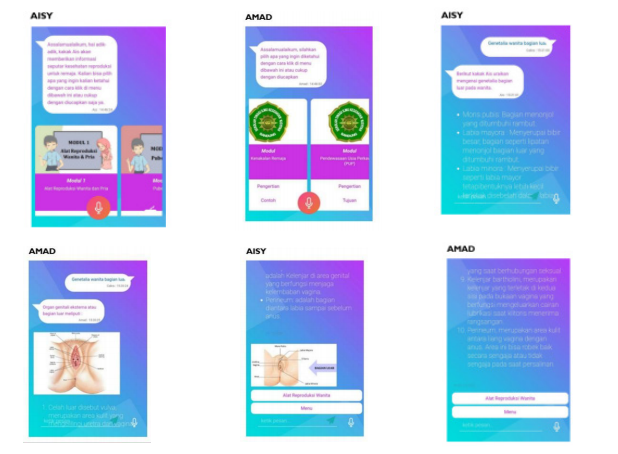Abstract
Background: Cognitive accessibility, psychosocial accessibility, and geographic accessibility are all barriers to adolescent sexual and reproductive health services. Cognitive accessibility, as an educational medium, provides access to comprehensive adolescent reproductive health information. This study aimed to turn a textbook into a learning module for adolescent reproductive health using artificial intelligence.
Methods: The study used the Borg and Gall Research and Development design. Purposive sampling was used to select the trial sample of students, teachers, and media experts at Muhammadiyah Junior High School 4 Margahayu, Bandung Regency. Interviews, validation sheets, and questionnaires were used to collect data. The data analysis technique was carried out based on the validation analysis results of media and material experts, as well as the module's feasibility according to students.
Results: At the research and information gathering stages, the research results were obtained by incorporating material from the previous module on menstruation and sexually deviant behavior, particularly LGBT. The planning stage included application aspects, materials, and usage instructions. With the addition of revised trial results in practice questions and adapted religious materials, the development results show that the module is ready for use.
Conclusions: According to the results of the study, the adolescent reproductive health learning module using Artificial Intelligence was appropriate as an educational medium. It is suggested that the press be improved in terms of media display and comprehensive material.
References
Baker, R.M.A. (2017). Adolescents Utilization of Website as a source of reproductive Health Information. International Journal of Advanced Research, 5(8). https://doi.org/http://dx.doi.org/10.21474/IJAR01/5258
Brayboy, L.M., McCoy, K., Thamotharan, S., Zhu, E., Gil, G., Houck, C. (2018). The use of technology in the sexual health education especially among minority adolescent girls in the United States. Current Opinion in Obstetrics and Gynecology, 30(5), 305–309. https://doi.org/10.1097/GCO.0000000000000485
Chung, J.W.Y., So, H.C.F., Choi, M.M.T., Yan, V.C.M., Wong, T. K. S. (2021). Artificial Intelligence in education: Using heart rate variability (HRV) as a biomarker to assess emotions objectively. Computers and Education: Artificial Intelligence, 2, 1–6. https://doi.org/https://doi.org/10.1016/j.caeai.2021.100011
Erdemir, K., Ingec, S. K. (2015). The Influence of Web-based Intelligent Tutoring Systems on Academic Achievement and Permanence of Acquired Knowledge in Physics Education. US-China Education Review A, 5(1), 15–25. https://doi.org/10.17265/2161-623X/2015.01.002
Government Regulation No. 61 of 2014 about Reproduction Health. https://peraturan.bpk.go.id/Home/Details/5502/pp-no-61-tahun-2014
Guse, K., Levine, D., Martins, S., Lira, A., Gaarde, J., Westmorland, W., and Gilliam, M. (2012). Interventions Using New Digital Media to Improve Adolescent Sexua; Health: A Systematic Review. Journal of Adolescent Health, xx(2012), 1-9. . http://dx.doi.org/10.1016/j.jadohealth.2012.03.014
Guzman, A. L. (2019). Voices in and of The Machine: Source Orientation toward Mobile Virtual Assistants. Computers in Human Behaviour, 90(343), 350. https://doi.org/10.1016/j.chb.2018.08.009
Haryati, S. (2012). Research and Development (R&D) sebagai Salah Satu Model Penelitian dalam Bidang Pendidikan [Research And Development (R&D) as a Research Model in Education]. Majalah Ilmiah Dinamika, 37(1). http://portalgaruda.fti.unissula.ac.id/index.php?ref=browse&mod=viewarticle&article=60637
Hermawan, S., Zuhrie, M. S. (2019). Rancang Bangun Modul Ajar dan Trainer Analog Line Tracer Robot pada Mata Pelajaran Perekayasaan Sistem Robotik untuk Meningkatkan Ketrampilan Peserta Didik SMK Negeri 1 Jabon [Design of Teaching Modules and Analog Line Tracer Robot Trainers in the Subject of Robotic Systems Engineering to Improve the Skills of Students of SMK Negeri 1 Jabon]. Jurnal Pendidikan Teknik Elektro, 8(3), 393–397. https://ejournal.unesa.ac.id/index.php/jurnal-pendidikan-teknik-elektro/article/view/29324
Kamal, M. (2020). RESEARCH AND DEVELOPMENT (R&D) TADRIBAT / DRILL MADRASAH ALIYAH CLASS X TEACHING MATERIALS ARABIC LANGUAGE. SANTHET: (JURNAL SEJARAH, PENDIDIKAN, DAN HUMANIORA), 4(1), 10–18. https://ejournal.unibabwi.ac.id/index.php/santhet/article/view/863
Grosz, B.J., Altman, R., Horvitz, E., Mackworth, A., Mirtchell, T., Mulligan, D., & Shoham, Y. (2015). Artificial Intelligence and Life in 2030. https://ai100.stanford.edu/sites/g/files/sbiybj18871/files/media/file/ai100report10032016fnl_singles.pdf
Perdana, R.P., and Irwansyah. (2019). Implementasi Asisten Virtual Dalam Komunikasi Pelayanan Pelanggan (Studi Kasus pada Layanan Pelanggan Telkomsel) [Implementation of Virtual Assistants in Customer Service Communication (Case Study on Telkomsel Customer Service)]. Jurnal Komunikasi, 11(2), 183–196.
Purnama, S. (2013). Metode Penelitian dan Pengembangan (Pengenalan untuk Mengembangkan Produk Pembelajaran Bahasa Arab) [Research and Development Methods (Introduction to Developing Arabic Learning Products)]. LITERASI: Jurnal Ilmu Pendidikan, 4(1), 19–32. https://doi.org/http://dx.doi.org/10.21927/literasi.2013.4(1).19-32
Rabiah, S. (2015). Penggunaan Metode Research and Development dalam Penelitian Bahasa Indonesia di Perguruan Tinggi [Use of Research and Development Methods in Indonesian Language Research in Higher Education]. Seminar Nasional dan Launching Asosiasi Dosen Bahasa dan Sastra Indonesia (ADOBSI), 1–7. https://osf.io/bzfsj/download/?format=pdf
Sa’diyah, H., Alfiyah, H.Y., Tamin AR, Z., Nasaruddin, N. (2020). Model Research and Development dalam Pembelajaran Pendidikan Agama Islam. El-Banat: Jurnal Pemikiran Dan Pendidikan Islam, 10(1), 42–73. https://doi.org/https://doi.org/10.54180/elbanat.2020.10.1.42-73
Sibiya, P. (2011). The Role of Research and Development in Industry and Commerce. International Journal of Scientific & Engineering Research, 2(8), 1–10. https://www.ijser.org/viewPaperDetail.aspx?AUG1140
Silalahi, A. (2017). Development Research (Penelitian Pengembangan) dan Research & Development (Penelitian & Pengembangan) dalam Bidang Pendidikan/Pembelajaran [Development Research and Research and Development in Education/Learning]. Seminar & Workshop Penelitian Disertasi Program Doktoral Pasca Sarjana Universitas Negeri Medan, 1–13. https://www.researchgate.net/publication/325681753_DEVELOPMENT_RESEARCH_PENELITIAN_PENGEMBANGAN_DAN_RESEARCH_DEVELOPMENT_PENELITIAN_PENGEMBANGAN_DALAM_BIDANG_PENDIDIKANPEMBELAJARAN_Disampaikan_pada_Seminar_Workshop_Penelitian_Disertasi_Program_Doktora
Susanto, T., Rahmawati, I., Wuryaningsih, E.W., Saito, R., Syahrul., Kimura, R., Tsuda, A., Tabuchi, N., Sugama, J. (2016). Prevalence of factors related to active reproductive health behavior: a cross sectional study Indonesian adolescent. Epidemiology and Health, 38(e2016041), 1–10. https://doi.org/https://doi.org/10.4178/epih.e2016041
UNFPA. (2016). Universal Access to Reproductive Health: Progress and Challenges. United Nations Population Fund. https://www.unfpa.org/sites/default/files/pub-pdf/UNFPA_Reproductive_Paper_20160120_online.pdf
United Nations Children’s Fund (UNICEF). (2017). The State of the World’s Children 2017: Children in a Digital Word. United Nations Children’s Fund (UNICEF). https://www.unicef.org/media/48581/file/SOWC_2017_ENG.pdf
Xie, C., Ruan, M., Lin, P., Wang, Z., Lai, T., Xie, Y., Fu, S., Lu, H. (2022). Influence of Artificial Intelligence in Education on Adolescents’ Social Adaptability: A Machine Learning Study. International Journal of Environmental Research and Public Health, 19(13), 1–12. https://doi.org/https://doi.org/10.3390/ijerph19137890
Yusuf, R.I. andHamdi, A. (2021). Efek Interaksi Penggunaan Media Sosial dan Pengetahuan Kesehatan Reproduksi Terhadap Perilaku Seksual Berisiko Remaja [Interaction Effects of Social Media Use and Reproductive Health Knowledge on Adolescents' Risky Sexual Behavior]. Jurnal Pekommas Special Issue 2021, The Role of Communication and IT against Covid-19, 35–45.
Wang H, Gupta S, Singhal A, Muttreja P, Singh S, Sharma P, Piterova A. 2022. An Artificial Intelligence Chatbot for Young People’s Sexual and Reproductive Health in India (SnehAI): Instrumental Case Study. Journal of Medical Internet Reseacrh. Vol. 24 No.1

This work is licensed under a Creative Commons Attribution-ShareAlike 4.0 International License.
Copyright (c) 2022 Fatiah Handayani, Nurhayati Nurhayati, Ami Kamila
